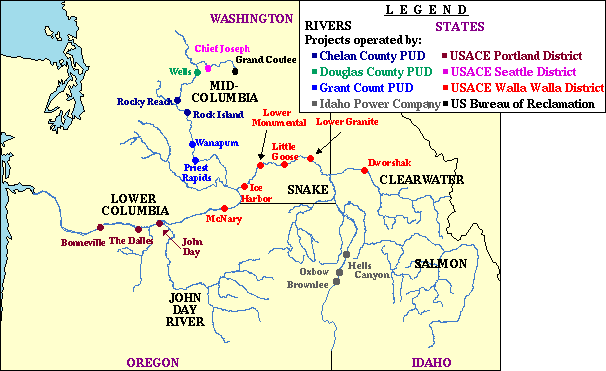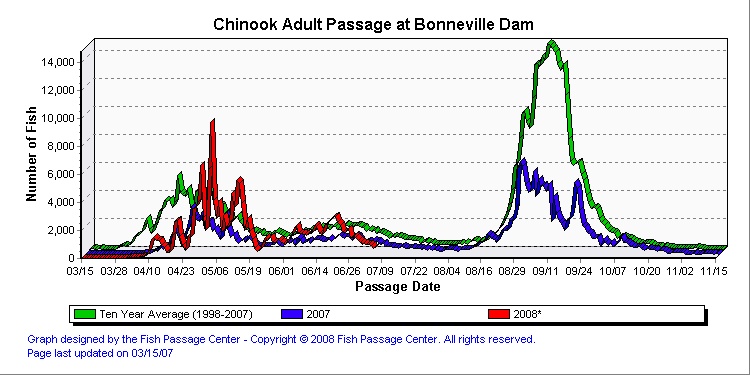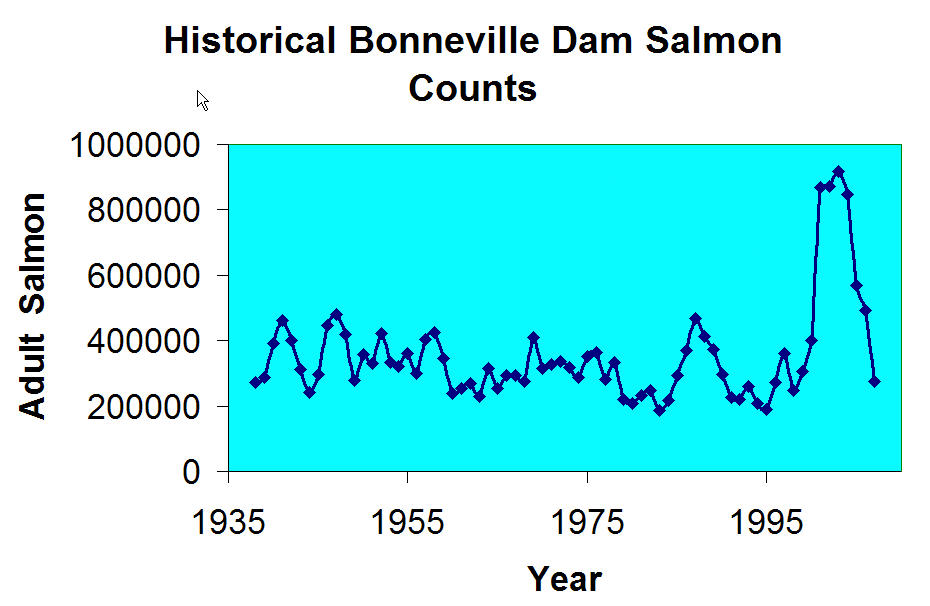
Let's first start at the issue of dams causing the decline of salmon. The principle hypothesis here is whether or not dams have cause a "catastrophic" loss of population.
We can use salmon count data as a means of establishing a baseline and to see if there is a decline in that baseline over time. We can then convolve that data with the following simple model:
X ----------|-------------|--------|------|--------|----|---|--|-> X'
1 2 3 4 5 6 7 8
Suppose we have a system where X salmon enter and have to pass 8
dams to reach X'.
The issues are:
Under the model where all dams are equal then we should see something like this in the data.
X1 < X2 < X3 < X4 < X5 < ...
While there may be other complicating factors such as salmon spawing tributaries between dams, it is reasonable to assume that the upstream migration pattern takes a hit each time that pattern encounters a dam. At least that is what we believe the outcome should be. These hypothesis can be tested to some extent by the actual salmon count data which exists at each dam ( Link to actual count data ) that exist within this overall system

Since your last homework assignment requires you to work with some of the data, we will skip the details here. But for now, we want to note the essential features of the count data:

If your going to count salmon, make sure you count when the salmon are seasonly expected (spring and early fall). So far, in 2008, the spring counts are much higher than the 2007 counts. Presumably this is related to the abundant supply of cold water in the Columbia as a result of this seasons much heavier than normal mountain snow fall.

The above shows the wave form of the historical salmon counts a bonneville dam - all counts at the other dams show similar wave forms. There a number of important and complicating features of this diagram that bear directly on the environmental issue of salmon decline.
| Problem | Dams | Logging | Changing Climate | Agriculture | Pop. Growth | Over Fishing | Other |
|---|---|---|---|---|---|---|---|
| Salmon Migration Barriers | Big Time | no | no | no | no | no | no |
| Barriers to Reaching Spawing Grounds | Yes | no | Yes | no | no | Yes! | no |
| Reduced Number of Young Salmon reaching sea | yes | yes | no | no | no | no | bird predation |
| Pesticide Exposure | no | Yes | no | Yes | no | no | no |
| Industrial Pollutants Exposure | no | no | no | no | Yes | no | no |
| Loss of Streamside Vegetation and Functions | no | Yes | no | Yes | Yes | no | no |
| Increased Sediment Load | no | Yes | Yes | Yes | Yes | no | no |
| Natural Habitat Destruction | yes | yes | no | yes | yes | no | no |
| Reduced Fresh Water Flow in Rivers and Streams | yes | no | no | yes | yes | no | no |
| Abnormal water temperatures | yes | no | yes | yes | no | no | no |
| Reduced upwelling and nutrient/food supply | no | no | yes | no | no | no | competition with hatchery fish |
| Estuary Degradation | no | Yes | no | no | Yes | no | no |
| Loss of cool deep pools in streams | no | Yes | no | no | no | no | no |
Finally, a few words about escaped salmon from fish farms:
The reason the issue of escaped salmon deserves our attention is that there are legitimate environmental concerns that result from a farmed fish escaping. In British Columbia, both Atlantic and Pacific salmon are being raised in farms and each of these two species poses unique risks once they do escape. For Atlantic, there's hybridization, which is basically Atlantic and salmon crossbreeding -- Atlantic and Pacific salmon crossbreeding. The other is predation and competition. This involves the Atlantic feeding on wild Pacific salmon, as well as other food supplies, and then the taking of space and the wild habitat in general.
Another major concern is spawning site disruption by Atlantic salmon. The stems from the fact that Atlantic salmon spawn later than Pacific salmon so there's a risk that they enter the same streams that the Pacifics have already spawned in and then they disrupt the eggs that the Pacific salmon have already placed. And also, Atlantic salmon mature faster than Pacific salmon, and so they have a competitive, or they give to the Pacific salmon a competitive disadvantage due to their smaller size. Another concern is colonisation of Atlantics in BC, which would have severe impacts on the wild stocks -- mainly because they would be using the same streams that wild Pacific stocks presently use to spawn. And finally, there is the issue of the spreading of diseases from the farmed salmon to the wild Pacific salmon.